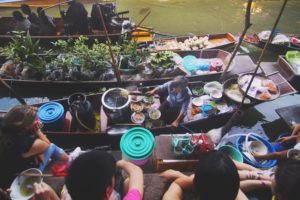 The culinary aspect is very important to me when I go on a trip. Trying the local specialties is the perfect opportunity to discover sensations never experienced before.
The culinary aspect is very important to me when I go on a trip. Trying the local specialties is the perfect opportunity to discover sensations never experienced before.
I am lucky to have no allergies and a resistant stomach to enjoy those culinary experiences. I had the chance to eat alligator in Louisiana, a pigeon in Egypt, a guinea pig in Peru and durian in Montreal.
However, some dishes on my list leave me a little perplexed. I think I should try them with my eyes closed and without knowing what it is.
Here are the 16 most bizarre Asian specialties I have found:
-
Fried tarantulas – Cambodia
They are found everywhere in the streets. They can be eaten with or without legs.
-
Eggs of century or hundred years egg – China
We must not rely on their name, they are not one hundred years old. They can be duck, chicken or quail eggs that are black on the inside. Depending on the method of preparation, they are preserved in a mixture of clay, ash, lime, salt and rice husks for several months. They have a strong odor of ammonia and sulfur
-
Donkey Penis – China
The Chinese believe that eating the donkey penis increases the libido! It is said that the taste resembles pork or bacon.
-
Bird’s Nest Soup – China
A mucus or saliva soup of little indigenous birds native to Southeast Asia who inhabit caves, which has dried and hardened.
-
Tong Zi Dan – China
The Tong Zi Dan is actually a hard-boiled egg in young boy’s urine. Once boiled, the shell is removed and allowed to macerate in the liquid for one day. They are found mostly in Dongyang, Zhejiang Province.
-
Silkworm Ragout – Korea
It is a kind of stew with insects that are normally responsible for producing silk.
-
Sannakji – Korea
The Sannakji is a dish of raw and live octopus. One must chew well so that the suckers do not remain hanging in the mouth or throat.
-
Burger Ikasumi (octopus ink) – Japan
Burger King created a burger only for Japan. The bread is made from a mixture of powdered bamboo charcoal and black sesame. The beef dumplings are marinated in an octopus ink sauce.
-
Fugu (globefish) – Japan
At your own risk. Only specilly trained chefs are allowed to cook this fish. It can be toxic if not prepared properly due to the tetrodotoxin it contains. There is no antidote for this poison.
-
Shiokara – Japan
The Shiokara is an octopus dipping into a viscous brown paste sauce composed of the salted viscera of the said octopus.
-
Tuna eyes – Japan
Tuna eyes can be either fried with garlic and soy sauce or prepared in a soup.
-
Tortang Utak – Philippine
The Tortang Utak is a raw pork brain omelet, usually served with vegetables.
-
Balut – Philippine
The Balut is a chicken or duck egg fertilized, whose embryo is almost completely developed. It is boiled and eaten whole with the shell.
-
Sea cucumber – Several Asian countries
The preparation of sea cucumber varies from one country to another. They can be cooked, fried, smoked, or even eaten raw (not recommended because the toxins it secretes).
-
Durian – Southeast Asia
Sweet and good Fruit, but that stinks enormously.
-
Tiet Canh – Vietnam
The Tiet Canh is a duck or goose blood soup and rich in protein that is served at lunchtime.
Will you dare try one of these out of the ordinary dishes?